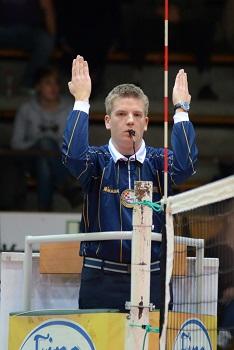

Volleyball referees use hand signals to indicate various plays and rules violations to players and spectators. The signal should not look like a touchdown signal. The referee should be able to see their partner, the court, and the benches beside them. Their hands are open with palms facing behind them, and they brush the fingertips once with the fingers of the opposite hand. When a player touches a ball on the side, it goes out of bounds the referee signals with their forearms perpendicular to the floor, elbows at a 90-degree angle, and a comfortable distance apart. If the ball goes out of bounds, the referee will blow their whistle to stop play and signal for a change of possession. This signal indicates that the ball is in play and that the players can continue to compete. The position of the thumb next to the index finger indicates that the ball is in play. The referee will extend their arm with their hand open toward the court and point 45 degrees away from their body near the intersection of the attack line and sideline. One of the most common hand signals is used to indicate that the ball is in play. When Ball Is In PlayĪ referee will use hand signals to communicate with players and other officials when the ball is in play. When making this signal, always keep this in mind so that the players know what is happening on the court. It’s essential to avoid making the signal look like the catch signal, as this could confuse. The arm is bent less at the elbow, then extended with the palm up. The improper service signal starts at the thigh. This occurs when the server doesn’t execute the service properly, for instance, by failing to hit the ball over the net. Volleyball referees use specific hand signals to indicate penalties. By using a one-handed signal, the referee can ensure that the players can still understand the call. This is used to indicate to the players that there is a delay in the service. The hand signal for the delay in service is raising both arms above your head. This is because these players are less likely to be familiar with the standard hand signals used by referees. The one-handed signal is used for game delays in matches involving players aged 14 and under. By using the same digits on each hand, the referee can ensure that the players are aware of the infraction regardless of which side of the court they are on. This hand signal indicates that the server has not touched the ball within eight seconds, causing a delay in play.

According to USA official volleyball, the Volleyball hand signals are shown when Delay in Service This hand signal lets everyone know that it’s about to be their turn to serve. Once the whistle is blown, the arm should be brought to the opposite chest. It is crucial that the palm is facing forward and that the whistle is blown before the signal is made.

This is the most crucial signal for volleyball referees, as it starts each rally. In the USA, the first referee in a Volleyball game officially uses the beckon for serve signal to start each rally. So, let’s look at some of the most important hand signals for volleyball referees! The Most Used Volleyball Hand Signal They are designed to clear up any confusion and provide a guide to the most common hand signals used in volleyball. There are a lot of hand signals that referees use to indicate plays and calls.

Learning the correct volleyball referee signals will help you play better and ensure that games are officiated correctly. This blog post will take a closer look at some of the most common referee signals in volleyball. Knowing what these signals mean can help you comply with the rules and avoid costly penalties. Volleyball referees use a variety of hand signals to communicate with players and coaches on the court.


 0 kommentar(er)
0 kommentar(er)
